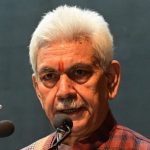CULTURE
Kashmir is a region known for its rich traditions and artistic expressions. The traditional folk songs here are an integral part of the cultural heritage. Often sung during weddings and other festive occasions, these popular songs are characterized by their melodious tunes, rhythmic beats, and meaningful lyrics. These tempting songs seem to have returned now back to cultural tapestry of Kashmir with a contemporary touch. The new musical stroke given to these songs by the modern artistry have brought them back to the masses. And with each passing day these songs besides locals are also sung by foreigners who visit here. Recently a Belgian lady tourist’s rhapsody went viral in social media performing Mahmood Gami’s famous folk-song in Dal Lake, Srinagar: “Brum dith waejnus naavey, gam chhum yaar maa raavey…” (Beguiled into love, I have been by a snare; apprensive I am, lest my beloved does disappear…). Her singing in fact evoked a new wave for these so appealing melodies. In Ramadhan, these folk songs were also sung by women in villages and towns during evenings.
These songs were chanted to in the honor of the holy month. When few days of this month were left, women showed warmth and enthusiasm in welcoming Idd-ul-Fitr. Their feeling was mixed. They welcomed Eid, and bade a tearful goodbye to Ramadhan. Earlier, the habit of singing “rouf” amongst Kashmiri women used to be common, but nowadays it seems to have been ignored only because the social position of women has considerably improved in recent years as a result of education. No doubt, the standard of living and mode of thinking of the people has considerably developed, but they should remember it as their heritage and asset. In past “rouf” used to be the core contentment for village women. They could hurriedly come out of their homes after taking Nun Chai (traditional tea) at Iftaar time and used to sing mellifluously. Some women used to sing dulcet rouf, others used to boom with fun, joking, joggle, dance and mockery, etc. The humorous presenting of these songs has often been remarkable:
Idd ahyee rase rase, Idd gah vasway,
Yeme unda Nabi saeb teme unde vasay,
Lejen chuvae vathran
Taway chu na naryan
Zungan chuve zung dud
Taway chu na narayan
(The festival of Eid came up with fervor, bit by bit. Let’s turn over to Eidgah, the side where our Prophet is present. Are you in trouble that you don’t come? Is there pain in your legs that you don’t come?).
Be it Rasul Mir’s, “Lalus wantai chus sawal; salus antanee baeliyay…” or popular melody sung by Shameem Azad, “Tosh tosh bulbulo son’th aewe waliyae, laliyay lajeye doorun graaeye…” There is, after all, much to delve into the history, significance, and various aspects of these traditional folk songs and to explore their cultural importance with artistic essence.
Historical Background
Kashmiri folk-songs have a long and storied history that dates back to centuries. They are deeply rooted in the cultural fabric of Kashmir with their origins often traced to the Sufi traditions of the region. These songs have evolved over time; have influenced by various musical styles and cultural exchanges only to make them a unique and cherished art form.
Musical Elements
One of the defining features of popular Kashmiri folk songs is their enchanting music. These songs are typically accompanied by traditional instruments such as the “tumbaknar” (a percussion instrument), “rabab” (a stringed instrument), and harmonium, etc. The combination of these instruments creates a harmonious blend of sounds that captivated the audience. The tunes were often intricate and emotive thereby reflecting the sentiments of the lyricists.
Lyrics and Themes
The lyrics of these songs were steeped in poetic beauty and carry deep cultural and emotional significance. They often celebrate love, nature, and the mysticism associated with Sufi traditions. These songs also narrate stories of Kashmiri folklore, portraying the region’s history and rich heritage. The themes in these songs were diverse ranging from expressions of joy and love to reflections on the beauty of the Kashmir Valley. Some songs like: “Roshe wala mane dilbaro, poshan baharo yurwalo…; Cholhama roshey roshey, waloo maine poshae madno…” or “Hariye thavakhna kante lolo, zaar mein totus wante lolo…” are undoubtedly having inspirational lyrics and themes.
Cultural Significance
Kashmiri folk songs played a vital role in preserving and promoting the cultural identity of the Kashmiri people. They are an essential part of social and religious ceremonies particularly during weddings. The performance of these songs during these events adds a sense of festivity and joy, making the occasions memorable for all involved. The songs also serve as a means of passing down the traditions from one generation to the next. Even today click videos at bride’s arrival by giving them the background music of popular Kashmiri folk-sung, “Zun chaek zoon aftaabus zamechh, zun chaek noor paeth paede gamachh; dekus chuev techh ta naste chuye chuni, cha kasey zoone zamachh chhek…”
Traditional Attire and Dance
The performance of Kashmiri folk songs was often accompanied by traditional attire and dance. Dancers, typically women, wore colorful “pherans” (traditional Kashmiri loose clad) and adorned themselves with intricate jewellery. The dance movements were graceful and rhythmic, complementing the music and lyrics. This visual spectacle added to the overall charm of these song performances. One such song is which is danced upon in the traditional attire is, “Machar aaw aabsharan, ba charun yaar kuth gou; Bae zaejnus lolenarun, ba charun yaar kuth gou…”
Evolution and Modernization
While Kashmiri folk songs remained deeply rooted in tradition, they have also evolved to incorporate modern elements. Contemporary musicians and artists have experimented with fusion of music combining traditional songs with the elements of pop and rock. This innovation has helped to introduce these songs to a broader audience while preserving the richest cultural essence. Take for instance the example of Kashmiri folk-song of Mission Kashmir movie, “Bumbro bumbro shaam rungh bumbro, kaze chukh euth nalano, ho ho…” The song has gone so popular that it is nowadays less sung by Kashmiris than outsiders.
Challenges and Preservation
Despite their cultural significance, Kashmiri traditional songs are facing challenges in the modern era. Socio-political conflicts and changing cultural dynamics have sometimes hindered the preservation and promotion of this art form. Efforts are being made by cultural organizations and artists to ensure the continued vitality of this richest cultural legacy, including documenting and archiving traditional compositions.
Bottom-line
Kashmiri folk songs are a treasure trove of cultural heritage and artistic expression. Their enchanting music, poetic lyrics, and vibrant performances are a testament to the rich traditions of Kashmir. These songs continue to play a vital role in connecting the Kashmiri people with their roots and sharing their culture with the world. It is essential to recognize and celebrate the beauty and significance of Kashmiri traditional songs as a precious part of our global cultural tapestry.
(The author is a teacher and regular columnist from Rafiabad. Email: [email protected])




